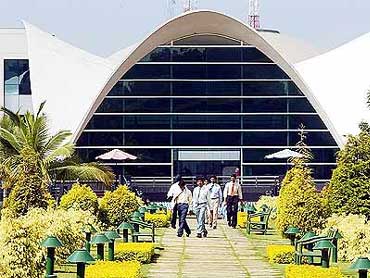 | « Back to article | Print this article |
Infy may have to hire a million, says report
Bangalore-based Infosys Technologies needs to revamp the growth strategy or end up hiring close to a million people over the next decade, as it eyes a 20 per cent compounded annual growth rate (CAGR) in revenue in the period up to 2020, says a BNP Paribas report.
Infosys employed 127,779 people at the end of the third quarter of 2010-11.
"The success of the company's strategy could address long-term concerns about its headcount-led model. We calculate that if Infosys has to achieve a 20 per cent CAGR in revenue at current productivity levels, it may have to employ close to a million in the next 10-12 years. Such scale could pose challenges of a level yet unthinkable," said Abhiram Eleswarapu and Avinash Singh of BNP Paribas in their report.
Infy may have to hire a million, says report
Infosys' employee utilisation percentage at the end of the third quarter was 80.7 per cent, excluding trainees. Including trainees, it was 72.6 per cent.
Too many heads?
Analysts believe the success of a non-linear model is crucial for the company, as managing a headcount growth over 10 times that of the present will be tough. And, the situation is similar for other firms.
"Recent concerns about manpower (attrition, quality of talent, rising wages) have led to companies questioning their so-far-successful offshore business model more than ever before.
We calculate that if current productivity levels continue and the large players have to deliver a 20 per cent CAGR in revenue for the next decade, Infosys, Tata Consultancy Sevices and Wipro will each need to employ close to a million people within the next 10-12 years," said the report.
Adding: "Expanding headcount could therefore lead to a new level of organisational challenges over the next few years, and any internal restructuring could cease to be news."
Infy may have to hire a million, says report
To avoid such a situation and to break the correlation between headcount and revenue growth, Infosys, TCS and Wipro have all come out with non-linear business models.
For Infosys the target is to have a revenue mix equally split between business transformation, strategic global sourcing and new engagement models.
"Attaining such a mix would need revenue from transformation (currently 26 per cent of revenue) and innovation (less than 10 per cent including product revenue) to increase significantly," said the report.
The report does mention that the company might look at some internal 'tweaking', that could happen later in the year, which is likely to be in line with Infosys' strategic road map for the next three-five years, and should ultimately lead to more autonomy for unit heads.
"We believe those tweaks could happen after September 2011, after the likely appointment of a new CEO, so that the new structure settles by March 2012, in time for the next fiscal year," noted the report.



